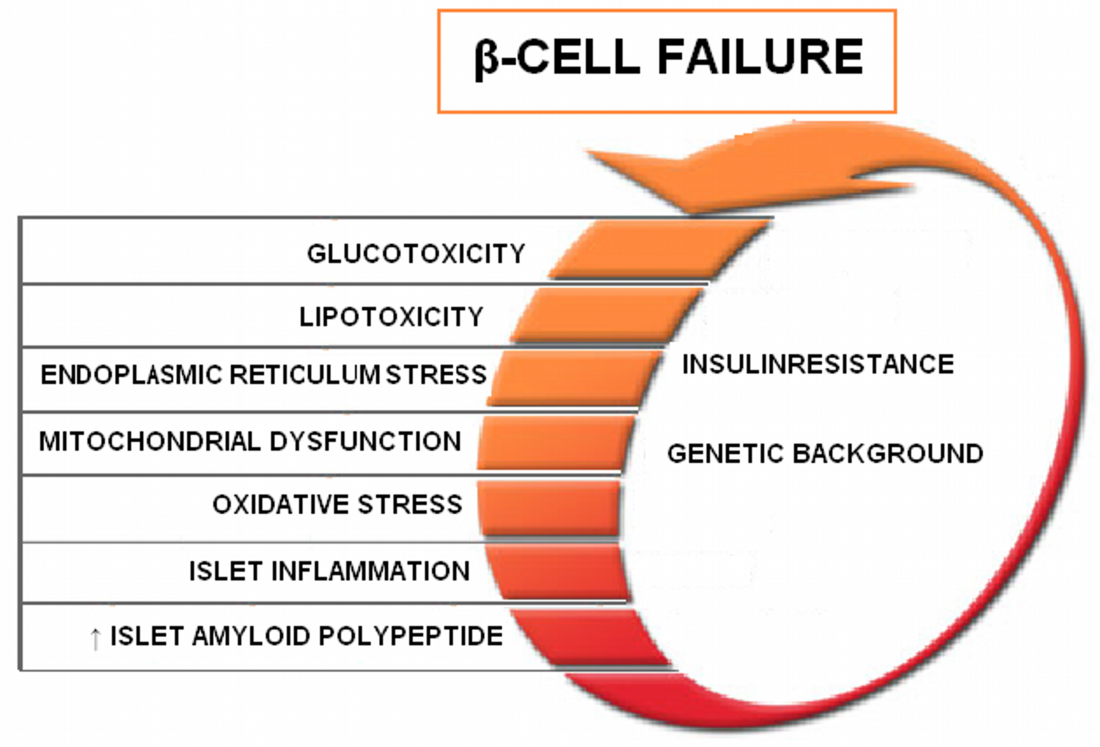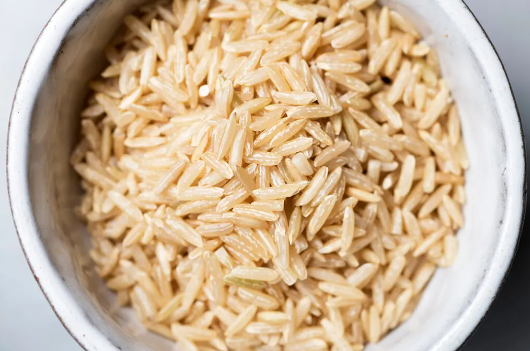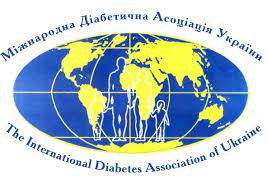Progressive beta cell dysfunction may be primary driver of impaired glucose tolerance by Michael Monostra for Healio.com/endocrinology, 1 December 2022.
 Loss of beta cell function serves as the basis for progression from normal glucose tolerance to impaired glucose tolerance, but insulin clearance may not be a major factor in the development of dysglycemia. In a presentation at the World Congress on Insulin Resistance, Diabetes & Cardiovascular Disease, Steven E. Kahn, MD, professor of medicine in the Division of Metabolism, Endocrinology and Nutrition at VA Puget Sound Health Care System and the University of Washington and director of the University of Washington Diabetes Research Center, discussed research that analyzed the relationships between insulin resistance, insulin secretion and insulin clearance with glucose tolerance, as well as the role beta cell dysfunction plays in the loss of glucose tolerance and the development of type 2 diabetes.
Loss of beta cell function serves as the basis for progression from normal glucose tolerance to impaired glucose tolerance, but insulin clearance may not be a major factor in the development of dysglycemia. In a presentation at the World Congress on Insulin Resistance, Diabetes & Cardiovascular Disease, Steven E. Kahn, MD, professor of medicine in the Division of Metabolism, Endocrinology and Nutrition at VA Puget Sound Health Care System and the University of Washington and director of the University of Washington Diabetes Research Center, discussed research that analyzed the relationships between insulin resistance, insulin secretion and insulin clearance with glucose tolerance, as well as the role beta cell dysfunction plays in the loss of glucose tolerance and the development of type 2 diabetes.
“I believe that it’s the beta cell and the dysfunction of the beta cell that is the basis for progression from normal glucose tolerance to impaired glucose tolerance and then to type 2 diabetes,” Kahn said during a presentation. “It also explains the progressive dysglycemia during treatment with glucose-lowering medications.”
To build upon previous research, more longitudinal studies analyzing the entire lifespan of a person, from conception until older age, are needed, Kahn said. These studies need to examine many factors, including pregnancy history, genetics, obesity, and body fat biomarkers, insulin sensitivity, beta cell function, insulin clearance, and glucose effectiveness, according to Kahn.
Read more: Progressive beta cell dysfunction may be primary driver of impaired glucose tolerance
What Are Whole Grains, Anyway? by Hannah Seo for NYTimes.com, 3 December 2022. A new study found that people aren’t getting enough of them. The first step to fix that, experts say: Better define the foods that qualify.
 A new study published on 11/30/22 in The American Journal of Clinical Nutrition found that between 2003 and 2018, adults in the United States consumed more whole grains than ever before. But exactly how much more they consumed was tricky to determine, the researchers reported, because the definition of whole grain food is murky.
A new study published on 11/30/22 in The American Journal of Clinical Nutrition found that between 2003 and 2018, adults in the United States consumed more whole grains than ever before. But exactly how much more they consumed was tricky to determine, the researchers reported, because the definition of whole grain food is murky.
Various institutions like the Food and Drug Administration and American Heart Association and industry groups like the Whole Grains Council have different criteria for which foods qualify, the researchers reported. And that lack of a standard definition, along with puzzling labeling on food packaging, makes it challenging for people to assess their consumption accurately, said Mengxi Du, a registered dietitian, PhD candidate in nutrition epidemiology at Tufts University and lead author of the study.
A grain is considered to be “whole” when it contains all three parts of the original kernel: bran, endosperm, and germ. Bran is the fiber-filled outer layer of a grain kernel that is full of B vitamins and minerals. The endosperm is a starchy carbohydrate middle layer with some proteins and vitamins. And the germ is a nutrient-packed core with vitamins, healthy fats, and other beneficial compounds.
Barley, brown rice, millet, oatmeal, wheat, rye, corn, and spelt are all common whole grains. (Quinoa and buckwheat are technically seeds but are often classified as whole grains in diets.) Whole wheat — including whole wheat flour — counts as a whole grain because it contains the three components, said Joanne Slavin, a professor of food science and nutrition at the University of Minnesota. White flour doesn’t count, she said, because it is milled in a way that removes the wheat bran and germ.
Whatever the source, whole grains are important to include in your diet because “they tend to be really nutrient- and fiber-rich,” said Maya Feller, a registered dietitian nutritionist based in Brooklyn. High-fiber diets have been associated with a range of health benefits, including regulated cholesterol and blood sugar levels and improved digestion, she said. “Depending on the type of grain that you’re consuming, they can be a fantastic source of B vitamins,” she added, as well as essential amino acids like methionine and phenylalanine.
Read more:
The Seeds Strike Back by Dani Blum for NYTimes.com, 26 August 2022.
 Chia seeds are making a comeback — again. They’re sprouting up on store shelves and packed into puddings and pretzels and even jams. According to forecasts from Grand View Research, a firm that tracks the food industry, the market for chia seeds is expected to grow by more than 22 percent per year between 2019 and 2025.
Chia seeds are making a comeback — again. They’re sprouting up on store shelves and packed into puddings and pretzels and even jams. According to forecasts from Grand View Research, a firm that tracks the food industry, the market for chia seeds is expected to grow by more than 22 percent per year between 2019 and 2025.
The seeds have long been a staple in Latin America and were even offered to Aztec gods during religious ceremonies, but every generation in America seems to think they’ve discovered them for the first time, said Beth Czerwony, a registered dietitian with the Cleveland Clinic’s Center for Human Nutrition.
During the last 40 years, chia has maintained a fairly constant presence in the public consciousness. They appeared as the furry plant Chia Pets in the late 1970s, and by the ’90s, health food companies started marketing them as a nutritional powerhouse. Over the past decade, in particular, the tiny seeds have garnered an outsized reputation: as a purported hack for weight loss, a protein supplement, and a staple of the ultra-healthy.
Chia seeds are not a magic conduit to weight loss or a cure for disease, but they are “incredibly healthy as a natural food source,” said Dr. Melinda Ring, an integrative medicine specialist at Northwestern Medicine.
Doctors and dietitians point to a few key health benefits:
-
-
- High in fatty acids: Chia seeds contain remarkably high levels of an omega-3 essential fatty acid known as alpha-linolenic acid or A.L.A. You can only get these acids from your diet, Dr. Ring said, and eating foods that are rich in A.L.A.s can help prevent heart disease. In fact, the seeds are one of the richest plant sources of omega-3 fatty acids
- Lots of fiber: Two tablespoons of chia seeds have around ten grams of dietary fiber — more than twice that of an apple. Fiber-rich foods promote gut health by encouraging bowel movements — hence, the thought behind the “internal shower.” But Dr. Lisa Ganjhu, an associate professor at the N.Y.U. Grossman School of Medicine who specializes in gastroenterology said she thinks of chia seeds as more of an “internal Brillo pad.” “It will definitely push things through,” she said.
- Contain antioxidants: Chia seeds are high in several potential antioxidants, which can help break down free radicals that damage our cells
- Handy workaround to dietary restrictions: Chia seeds, which are gluten-free and vegan, as an egg substitute, using a similar consistency to bake pancakes and breads. They are a good source of protein, although considerably less so than soybeans or quinoa.
-
Read more: The Seeds Strike Back
A Ukrainian Startup Rolls Out Mobile AI-Powered Screening Solution for Diabetic Retinopathy For Internally Displaced People, posted 5 December 2022, as a CheckEye.IDF media release.
I received an interesting email last week … interesting:
 My name is Kyrylo Goncharuk, Board Member of the UDF (Ukrainian Diabetes Federation). I am also the CEO and founder of CheckEye, a Ukrainian health tech startup developing its proprietary AI-powered technology to detect diabetic retinopathy. Here at the Congress, the UDF in partnership with CheckEye is presenting our technological achievements (92% sensitivity, 84% specificity in detecting DR) as well as our innovative approach to organizing the screening process.
My name is Kyrylo Goncharuk, Board Member of the UDF (Ukrainian Diabetes Federation). I am also the CEO and founder of CheckEye, a Ukrainian health tech startup developing its proprietary AI-powered technology to detect diabetic retinopathy. Here at the Congress, the UDF in partnership with CheckEye is presenting our technological achievements (92% sensitivity, 84% specificity in detecting DR) as well as our innovative approach to organizing the screening process.
As a result of the Russian invasion, Ukrainian healthcare services have suffered a huge disruption while millions of people have been internally displaced. Together with the UDF and The Filatov Institute of Eye Diseases and Tissue Therapy, a leading eye health academic institution in Ukraine and globally, we have rolled out a mobile screening solution that allows for eye screening in the field without the involvement of highly trained medical personnel.


I think if it is structured correctly CheckEye could have value in doctors office for a quick screening. I love the idea of it.
Whole grain? It is a mess competing labels and half truths. We want less gluten, less carb, half the sugar and twice the size of a slice.